ROMAN SWORDS
From the beginning of the times, the man in his necessity of defense and its eagerness of conquests, has been developing a type of agreed armament with the historical moment that lived. Dividing of first stones and sticks of wood or bone there has been an important evolutionary process as far as the offensive weapon talks about conductor, through the centuries, of the search of new resistant and more and more lasting materials that allowed the manufacture of better arms, and of a morphologic development that adapted these arms to the necessities of every historical period.
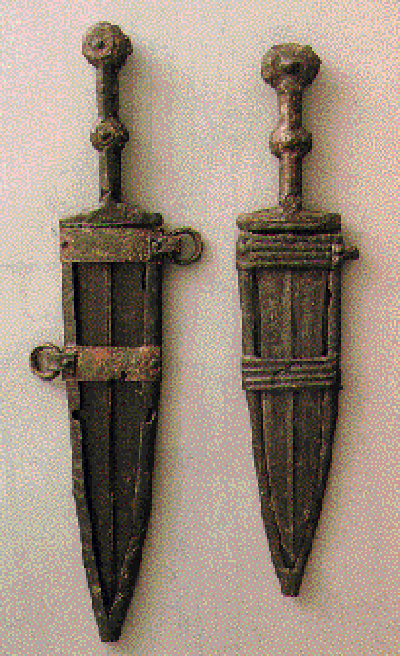
Roman swords caracterized for its short lenght.
The discovery of metals and its form to work them, supposed a great advance in the armaments industry, being able to make new instruments of attack and defense in a material easier to work and more lasting. This new stage would arise with the obtaining from copper from the mineral, having made primitive utensils, but due to their softness in pure state, hardening forms looked for. The development of the metallurgical furnace, starting off possibly of a furnace of ceramics or food baking, would initiate the production in mass of the primitive armament, to the power to fuse existing minerals in the Age of the Bronze: lead, receives, tin and of course gold and silver. Thus, with the obtaining of new alloys or metals in a pure state semi, new forms could be obtained that nor the most expert man who carves would have obtained in stone or bone, without forgetting that a metal weapon, as would be the sword, once broken was the more easy to restitute becoming to fuse, impossible thing with the stone.
This possibility of new forms from the smelting of the metal, took to the primitive gunsmiths to the present time to develop a portable model of armament that has not let evolve in form, size and technique of use. We of course talked about the sword, explaining maximum of the armaments panoply of the soldier and accompanying faithful through the centuries in all luck of fights.
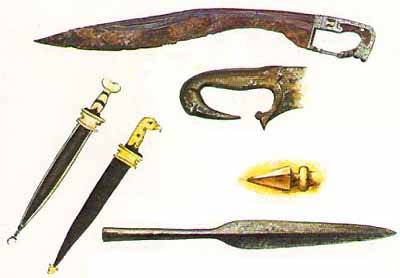
Diferent models of roman swords.
It was in the Second Punic War when the Romans had to do them to it with this formidable sword who carried the Spanish infants of Anibal. This Spanish sword was made in iron of highest quality, the leaf had double average edge and 50 cm. in length by 7 cm. wide. The Spanish sword had a great end that turned it an exceptional marksman been by an infant covered by a great shield, since the only thing that it had to make era stop the edge of the long sword of the adversary with the shield and cross it through. The Spanish sword was used of end, for "puncture" to the adversary, with which the arm that only handled it had to move towards ahead and not upwards and the infant who handled it exposed unless with a cut sword. Handled by the expert Spanish infants in their wars against Rome, these formidable swords caused such terror in the Roman legionaries who the Senate decided to adopt it like weapon standard in the Roman equipment replacing the Greek sword of hoplite. Of the Spanish sword one has said that no other weapon has killed to more men throughout History until the arrival of the firearms. And it is certain. The dagger is also Spanish, the leaf measured about 24 cm. in length by 6 cm. wide.
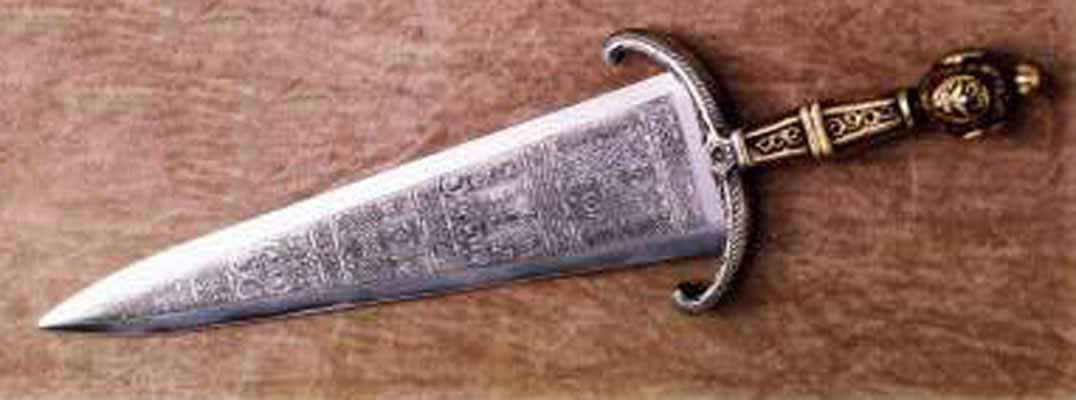
Cinqueada sword was used by the romans.
The Roman sword, famous "Gladius Hispaniensis", it is inspired as its name indicates in the Hispanic short sword. At diverse historical moments they were appearing different models from swords Roman that they have been catalogued by the name of the place where were the rest.

Roman gladius is the most famous sword fo the romans swords.
The development of the Roman sword like basic equipment of the soldier, did not happen unnoticed for the powerful Roman machine military, which armed mainly to its legions with two types of sword. The Roman army composed basically by infantry, depended in certain way of its allied troops to form an effective cavalry, organizing this one last one from native troops who dressed and they were armed of own form. During the war of the Galia, To stop raised a strong body of cavalry that used a type of long Roman sword that would give rise later to the denominated Spatha. On the origin of this one, several theories exist, being accepted, than it arises from the evolution of the Celtics swords of the last period of Tene III. On the contrary the infantry, equipped with a Roman sword shorter Gladio call, that behaved in brigand on the right flank. Originally these Roman swords were of blunt end, being developed later a wide sword of acute triangular end based on the Hispanic sword, arises then the call Gladio Hispaniensis.
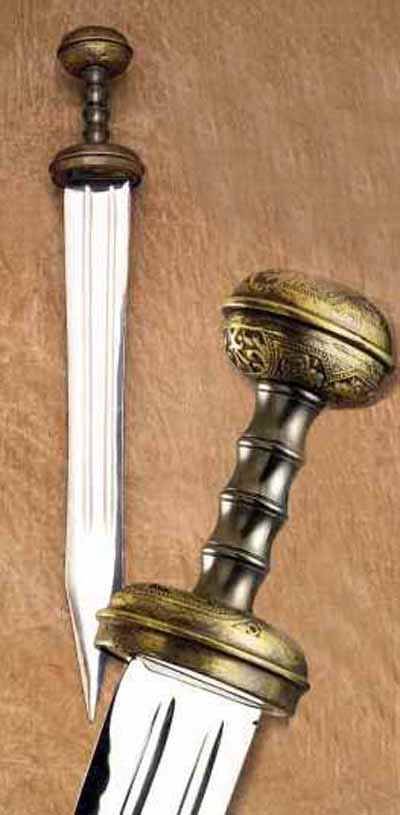
Roman gladius wich a different finished.
The leaves of the Roman swords were of two edges with a rhomboid or biconvex section, without flutes nor adornments. Some of these Roman swords were compound on the one hand central of low carbon steel with rich carbon steel edges, others had low a carbon steel soul surrounded by rich a carbon steel outside and another one was compound more totally of low carbon steel. The piston rod was an extension of the leaf of the sword, that projected through the grip. The end was riveted on a washer or a decorative nail.
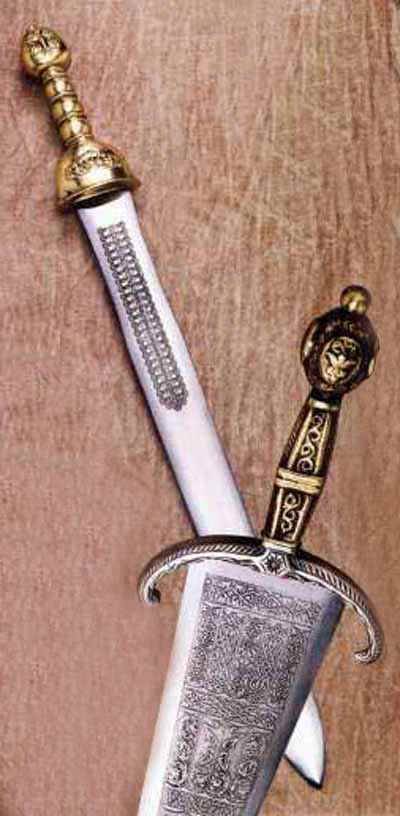
Roman sword and cinqueada sword made artesan in Spain.
The Roman swords took in the right side, hanging high of a leather shoulder belt of 1.25 to 2.5 cm. wide. The shoulder belt clasps that can be seen in some modern reconstructions are in fact adornments for harnesses of horses. The case had four ring to hang, in the back part the shoulder belt was divided in two and it stuck close to both ring, whereas in the single advantage the upper barrel band is used, as much sewing as by means of a clasp. The shoulder belt could be dyeing. One more a older form to carry the Roman sword, commonest perhaps in those of type "MAINZ", it is to hang it of the belt, although we do not know with exactitude like became. It would imply the use of short leather strap together with the ring, or forming a bow or intercrossing. In the beginning, gladius hispaniensis had single two ring in the back part of the case. Have been rest with small clasps together with the ring, which suggests the use of strap that united it to the belt. Probably the use of four ring prevailed at the end of century I before Christ
 Cookie preferences
Cookie preferences
 WhatsApp
WhatsApp
 Call us
Call us
 FAQs
FAQs